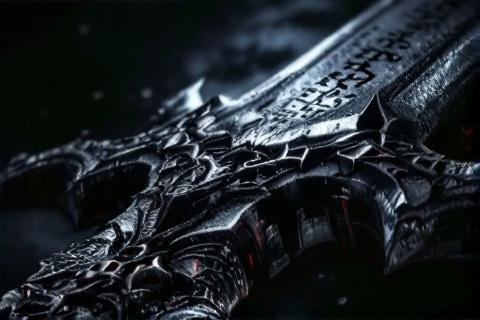
Gurthang: Túrin's Doom Blade
The Tragic Tale of Middle-earth's Most Cursed Sword
Origins in Meteoric Iron: The Birth of Anglachel
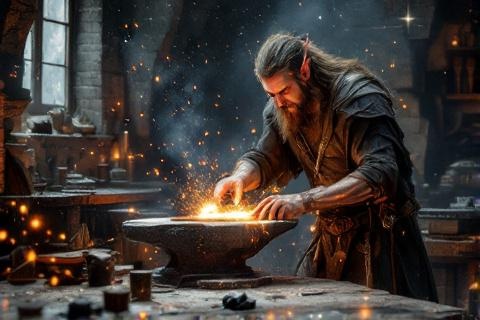
Gurthang's origins can be traced to the masterful hands of Eöl the Dark Elf, who
discovered a mysterious meteorite in the forests of Nan Elmoth. This reclusive
elven smith, known for his exceptional skill in metalworking,
forged the great black sword from the star-fallen metal during the First
Age of Middle-earth. His craftsmanship
was unmatched in the working of meteoric iron, which he learned through secret
methods developed in isolation.
The metal from which Gurthang was forged possessed unique properties that set it
apart from earthly iron. This meteoric iron was exceptionally hard yet malleable
under specific forging conditions, and it retained a distinctive black color
that would never fade. The metal absorbed and reflected light in an unusual way,
giving the blade its characteristic dark appearance with a faint, sinister
gleam.
The use of meteoric iron was highly significant in elven smithing traditions,
particularly among the Sindar and certain isolated elven
craftsmen. This space-born metal was believed to possess inherent magical
properties, and its celestial origin made it particularly suitable for crafting
weapons of great power. Eöl's mastery of this material was unique even among the
Eldar, and his techniques remained largely secret, known only to himself and
partially to his son Maeglin.
From Anglachel to Gurthang: The Reforging
The black sword's path to renown began when Eöl presented it as tribute to King
Thingol of Doriath, acknowledging the Sindar king's lordship
over Nan Elmoth. Originally named Anglachel, meaning
'Iron of the Flaming Star,' the sword was accepted by Thingol and kept in his
armory as a weapon of great worth but dark nature.
Beleg Cúthalion, chief of the marchwardens of Doriath, obtained the sword from
King Thingol's armory before departing on his quest to find Túrin. Thingol
granted him the blade despite Melian's warnings about its
malicious nature, recognizing that Beleg would need a weapon of extraordinary
power for his dangerous mission beyond the Girdle of Melian.
Following the tragic death of Beleg, the black sword was taken to
Nargothrond where it was reforged for Túrin
Turambar. During this reforging, Túrin renamed the
blade Gurthang, meaning 'Iron of Death,' a name that would prove prophetic. The
skilled smiths of Nargothrond restored and enhanced the blade's deadly
properties, though they could not alter its essential nature or the doom that
lay upon it.
Physical Description and Unique Properties
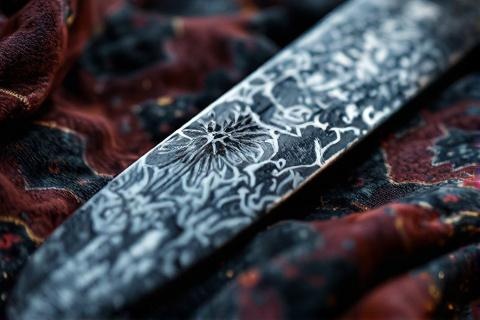
Gurthang's physical appearance was dominated by its distinctive black metal,
which seemed to drink in light rather than reflect it. The blade maintained a
pale, ghostly gleam along its edges that seemed to shimmer with an inner malice,
marking it as clearly distinct from any other sword in Middle-earth. This unique
appearance made it instantly recognizable and struck fear into the hearts of
foes.
The sword possessed an unmatched sharpness that could cleave through iron and
stone. Its strength was legendary, able to withstand tremendous forces without
notching or breaking under normal combat conditions. These qualities made it one
of the most formidable weapons of the First Age, capable of matching even
dragon-hide in battle.
Perhaps most remarkably, Gurthang demonstrated the ability to speak, though only
once recorded in history, during its final moments with Túrin Turambar. This
extraordinary property suggested that the blade possessed some form of
consciousness or spirit, setting it apart from other magical weapons of the
Elder Days.
The sword exhibited signs of possessing its own will and consciousness, acting
almost as an entity unto itself. It was said to possess a malicious joy in
battle and drinking blood, particularly that of its enemies. This sentience was
noted by both Melian the Maia and others who encountered the blade, suggesting
it was more than merely a magical weapon but rather a being with its own dark
purpose.
The Curse of the Dark Sword
The malevolent nature of Gurthang was intrinsically linked to its creator, Eöl
the Dark Elf. His brooding personality, isolation, and deep knowledge of dark
arts were believed to have been transferred into the blade during its forging.
Melian herself recognized this connection, warning that the black blade retained
something of Eöl's dark and bitter spirit.
Throughout its history, Gurthang demonstrated an unsettling tendency to betray
those who wielded it, regardless of their intentions or nobility. This trait
manifested most tragically in the death of Beleg Cúthalion at Túrin's own hands,
guided by the blade's malice in the darkness of night.
The sword's connection to Túrin's doom was profound and inextricable. As an
instrument of fate, it participated in both his greatest victories and his
ultimate tragedy, serving as both the tool of his heroic deeds and the means of
his death. The blade seemed to be a physical manifestation of the curse of
Morgoth upon Túrin's house, working inexorably toward its
master's destruction.
Notable Wielders and Their Fates
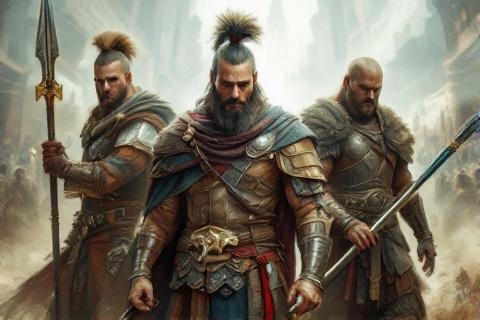
Eöl's initial ownership of the sword established its dark legacy. As its
creator, he imbued the weapon with properties that reflected his own mastery of
metalcraft and his mysterious knowledge of the dark arts. His craftsmanship was
unmatched in this regard, creating a weapon that would endure as one of the most
famous and feared blades in the history of Middle-earth.
Beleg Cúthalion's possession of the sword, though brief, was significant in the
blade's history. As one of Doriath's greatest warriors, his use of the sword
demonstrated its tremendous potential for both good and ill. His tragic end
while bearing the blade became one of the most sorrowful tales of the First Age.
Túrin Turambar became the final and most renowned master of the black sword.
Under his wielding, Gurthang achieved its greatest fame and most terrible deeds.
The relationship between Túrin and his blade was complex and fateful, as the
sword became both his most trusted weapon and the instrument of his doom.
Role in Major First Age Events
The death of Beleg Cúthalion stands as one of the most tragic events in the
history of Gurthang. In a terrible moment of mistaken identity, Túrin slew his
closest friend with the very blade Beleg had carried to rescue him. This event
marked a crucial turning point in both the sword's history and Túrin's tragic
tale.
Under Túrin's wielding, Gurthang achieved numerous victories against Morgoth's
forces. The black sword became legendary among the enemies of Morgoth, who
feared its deadly efficiency. In the halls of Nargothrond and the forests of
Brethil, the blade earned its reputation as one of the most formidable weapons
in the war against the Dark Enemy.
The slaying of Glaurung, Father of Dragons, was
Gurthang's greatest achievement. In this monumental battle at Cabed-en-Aras,
Túrin used the black blade to deliver a fatal wound to the mighty dragon,
striking from beneath at the one vulnerable spot in Glaurung's armored hide.
This victory, though bought at a terrible price, established Gurthang's
reputation as one of the few weapons capable of penetrating dragon-scale.
The Sword's Final Fate
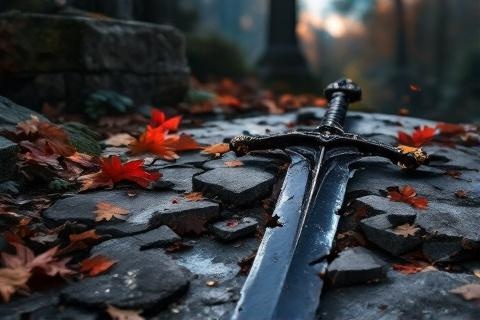
In the final moments of Túrin's life, Gurthang demonstrated its sentience in a
chilling dialogue with its master. When Túrin sought death by his own blade, the
sword spoke to him, acknowledging its role in the deaths of both Beleg and
Brandir, and accepting its final task of ending its master's life. This
conversation stands as the only recorded instance of the blade speaking.
Upon Túrin's death, Gurthang broke into shards, its black metal finally yielding
as it tasted its master's blood. The breaking of the blade marked the end of its
long and tragic history, suggesting that its purpose and existence were
inexorably bound to Túrin's fate.
The shards of Gurthang were buried alongside Túrin beneath the Stone of the
Hapless, marking the final resting place of both the tragic hero and his
infamous blade. This burial site, overlooking the waters of Cabed-en-Aras where
Niënor had ended her life, became a testament to the complete tragedy of the
Children of Húrin.
Legacy in Middle-earth's Lore
Among the great swords of the First Age, Gurthang stands unique in its dark
nature and tragic history. While other famous blades like Anglachel's
sister-sword Anguirel, or Ringil wielded by Fingolfin,
were renowned for their powers and deeds, none possessed the combination of
sentience, malice, and doom that characterized Gurthang.
The black sword's role in the legend of Túrin Turambar is central to
understanding the tragic hero's tale. It served as both a symbol and instrument
of his fate, participating in his greatest victories and deepest sorrows. The
blade's history became inseparable from Túrin's own story, enhancing the tragic
elements of his legend.
Within Tolkien's broader mythology, Gurthang represents themes of fate, free
will, and the double-edged nature of power. The sword's ability to achieve great
deeds while simultaneously working toward its wielder's doom reflects the
complex moral landscape of Middle-earth, where power often carries unforeseen
consequences.
The tale of Gurthang continued to influence the songs and stories of the Elder
Days long after its breaking. Bards and loremasters of later ages would recount
the blade's dark deeds and its role in the tragedy of Túrin, making it one of
the most remembered weapons in the annals of Middle-earth. Its legacy served as
a warning about the price of power and the inescapable nature of fate.
